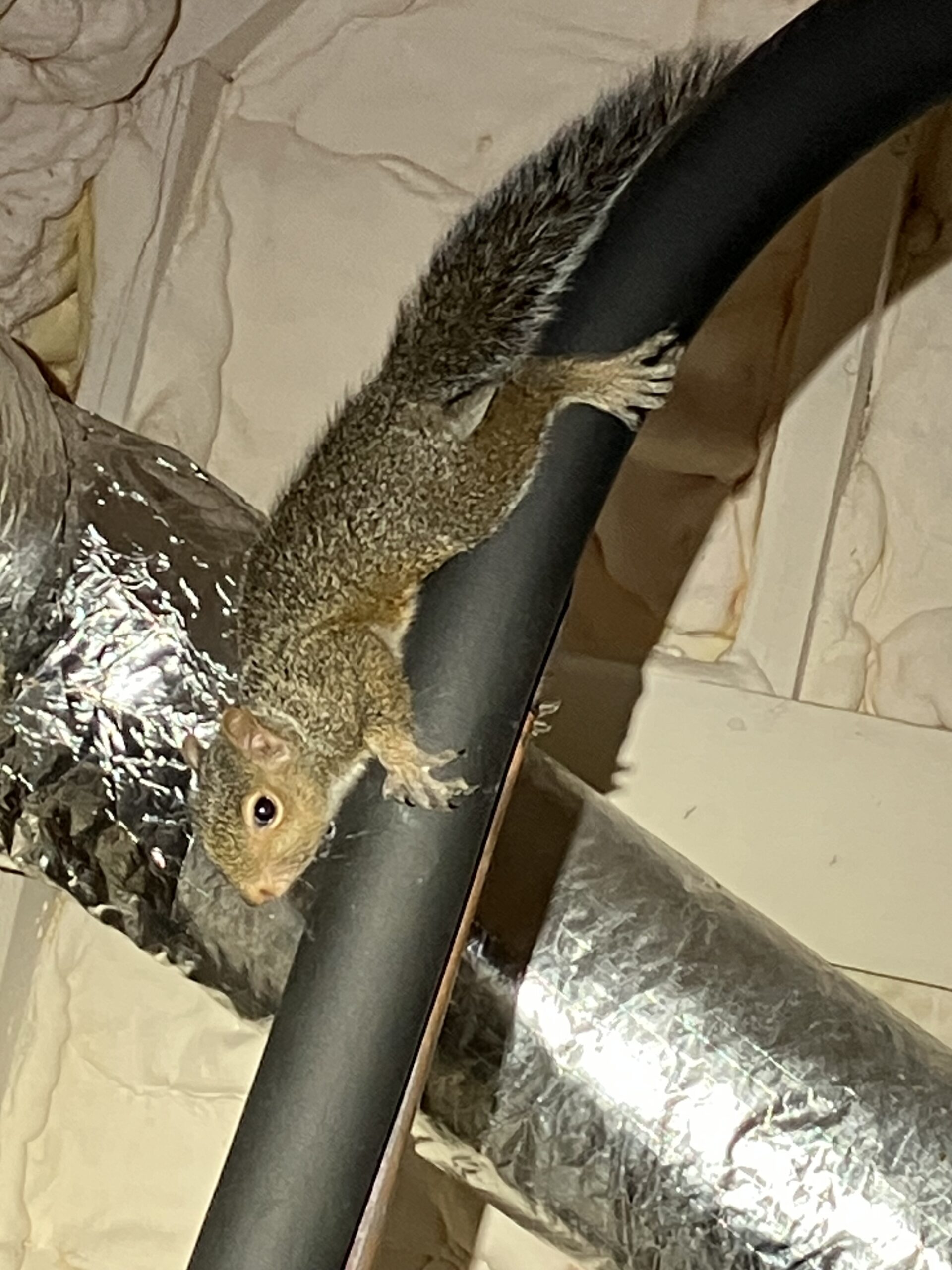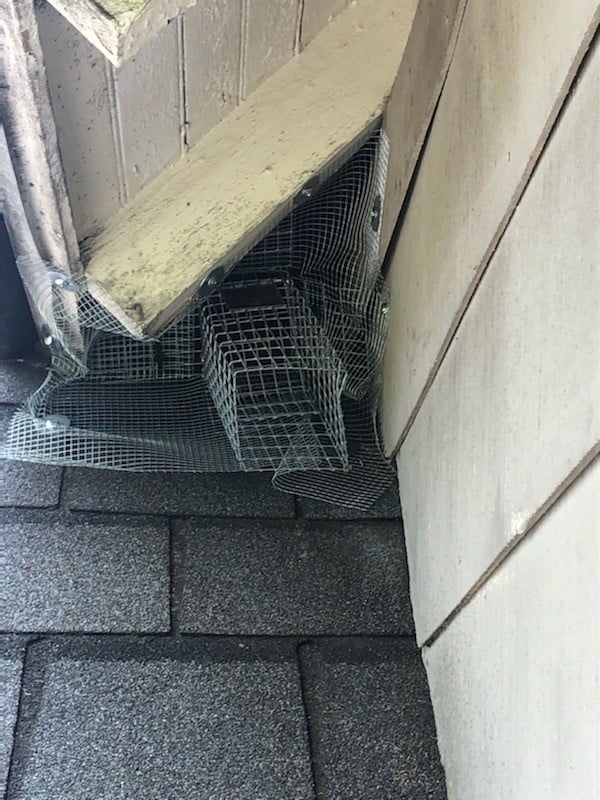Squirrels might be adorable when scampering about the yard, but they quickly lose their charm when living within a home’s walls or attic. Squirrels in homes are energetic and nimble creatures that excel at creating costly damage.
Like most nuisance pests, they’ve become accustomed to living among people because as urban and suburban areas grow, their habitats shrink. So when they need a warm, secure place to nest for the winter and raise their young, homes become their choice of residence.
The professionals at Critter Control can safely and humanely remove the squirrels and install solutions to prevent future squirrel problems.
Identify Squirrel Problems in Attics

Squirrels have different motivations for entering your attic. Most often, squirrels create nests in the attic to give birth and raise their young.
Female squirrels each year typically have two litters that contain an average of two to four young, but can carry up to eight. Litters are usually born in late winter and midsummer. Attics, walls, and crawl spaces are the most common places for squirrels to enter homes.
Squirrels do not hibernate. They do need a warm shelter that protects them from harsh winter weather.
Squirrels often cause damage to attic insulation or electrical wiring in the attic. But the most damage is done over time as multiple litters of squirrels are born in or near the home. As these squirrels grow and leave the nest, they often will set up their own nests within the same attic.
If the initial intrusion is not addressed in time, the damage to your home will increase quickly. Not only will they continue to chew through wiring and damage insulation, but in doing so, they will create more entry points for other squirrels.
Signs of Squirrels
Sounds. There’s a good chance you’ll hear a squirrel before you see any visual evidence, especially during winter months, where you’re less likely to notice exterior damage. The sounds squirrels make are often described as scurrying, scampering noises. You might also hear chewing or gnawing sounds. Squirrels like building their nests in attics, so sounds will often emanate from there. Squirrel sounds are often mistaken for rat sounds, but there’s one key difference: squirrels are diurnal, so you’ll hear them during the day, whereas rats are nocturnal, and will make more sound at night.
Nests in Your Attic. Squirrels are well known for nesting in attics, as they provide a safe hideaway for squirrels to raise their young. The inside of an attic is also full of things for them to nibble and sharpen their ever-growing teeth on, like wood and insulation. When a squirrel chews the insulation on electrical wiring, the possibility of a house fire arises. Squirrels enter attics through crevices, gaps, and cracks in soffits, fascia boards, and eaves, or open vents or broken shingles in the roof. Once squirrels reach the attic, they have free reign of the house.
Chewed Roofing Materials. Another popular nesting site for squirrels is in the roof. Typically, they build these nests with roofing insulation. Take some time to carefully analyze your home’s exterior carefully.
Squirrels commonly damage roofs by:
- Chewing holes in soffits. This can allow other small pests to invade your home.
- Biting through shingles. This can lead to water damage.
- Eating through joists and siding. This can weaken your home’s structure.
To prevent squirrels, it is critical to keep one’s roof in good shape. Regularly inspect it for any damage, and repair as needed. To cover small holes, use steel mesh, not aluminum or plastic. Squirrels can chew through plastic and soft metals like butter.
Damaged Gardens. If you walk out to your garden to find it full of bite marks, a squirrel is one of the more likely culprits. Squirrels eat a variety of popular garden vegetables, including spinach, kale, corn, fruit, and nuts. Squirrels are equally drawn to fruiting trees like citrus, fig, apple, plum, and peach trees. Protecting your garden from squirrels can be as simple as installing a wire mesh cage around your garden, and installing a metal collar around 6-8 feet up the trunks of vulnerable trees.
Squirrel Droppings Inside Your Home. Squirrel droppings are often confused for rat droppings, and vice versa. While rat and squirrel droppings do look similar—dark brown to black in color with blunted ends, around 3/8 of an inch long—they are found in different places around the home. Squirrel droppings are often found in attics or around tree trunks, while rat droppings are more common along baseboards, in cupboards, and behind large appliances like washing machines.
Where Do Squirrels Live around Washington DC?
Tree squirrels enter homes looking for shelter. Some types of squirrels can give birth to two litters in a year. During their breeding period, female squirrels can build nests (dreys) in attics or wall cavities. Homeowners typically notice these litters during late spring/summer and autumn.
In the winter, they are likely to invade homes and other structures to ride out the harsh winter months. Because they do not hibernate, squirrels build caches of nuts to eat. It’s not uncommon to find squirrel caches inside your home after the cold weather.
- Soffits – These are the finishing material, mostly made of wood or fiber cement, that covers the underside of a roof overhang. In addition to helping to make the roofline look aesthetically nice, soffits help keep moisture away from the rafters, reducing the chance of mold. Soffits that are not flush with the siding create a gap for squirrels to enter.
- Fascia Boards – These are thin, long boards that run along the lower outer edge of a roof, covering the entire roofline. They help keep water out.
- Ridge Vents – Ridge vents are air exhaust vents installed on the peak of a roof that provides continuous exhaust ventilation at the highest part of the attic. Squirrels are attracted to the warm air that comes out of these vents.
- Gable Vents – On a gabled roof, these vents are located at the peak where the two sides meet. They usually have louvers, allowing air to flow into the attic, which works to cool it down in warm weather.
- Roof Returns – This is the part of the roof that doubles back to the wall of the house. It is between the end of the roof and a home’s walls.
- Chimneys – Chimneys conduct smoke and combustion gasses up from a fireplace, stove, or furnace and can run through the attic of a house.
- Siding Corners – This is the trim used to keep your siding in the place where the corners meet.
- Gutters – Gutters capture rainwater and melting snow and channel it away from the house. Clogged gutters that prevent precipitation from running will cause deterioration along the roof edge through which a squirrel can enter.
- Plumbing Mats – This is rubber matting covering cylindrical vents on the roof that connect the plumbing system used to exhaust gasses.

Example of the squirrel entry point.
How We Get Rid of Squirrels
Critter Control specializes in squirrel removal. To remove a squirrel or family of squirrels on your property, our wildlife specialist will perform a thorough inspection to determine the severity of the problem. After the inspection, they will build a custom solution to trap, remove, and seal all entry points. They will also provide warranty options as well as an estimate for preventative services.
Squirrel Removal Services Near You

When performing squirrel removal, our wildlife professional will determine the most effective and humane way to remove the squirrel(s) from your property.
The most common methods used are:
- squirrel trapping
- one-way doors
- deterrents
- direct capture.
Squirrel Trapping near Washington DC
We do not directly capture adult squirrels as they move too quickly and fit in very small spaces. If juveniles are found in an attic, they will be hand removed and relocated with their mom. If the mom is not in sight and the young cannot survive on their own, our wildlife specialists will seek help from a local wildlife rehabilitation center.
Removing squirrels can be very tricky since they run, climb, and jump very quickly. While technically allowed to catch squirrels with nets or catch poles, it is nearly impossible. Squirrel trapping is one of the safest and most effective squirrel removal strategies.
The best squirrel trap is to use a 5- x 5- x 18-inch (minimum) cage or box traps. Box traps are built with solid walls, usually of wood, plastic, or sheet metal. Cage traps are made of wire mesh. For squirrels, use a cage trap from ½- x 1-inch mesh.
Both live traps can in either one-door or two-door traps. Mouse traps (snap traps or glue traps) will not work to trap squirrels.
Squirrel Exclusion & Prevention
Home exclusion is the most effective method to prevent squirrels or nuisance wildlife from entering your home. It is essential to seal all current and potential entry points to prevent future squirrel infestations. After the squirrels have been removed, it is essential to prevent future squirrel problems. Whole home exclusions identify any potential entry point such as gaps around siding, vents, chimneys, and windows, to keep squirrels out of homes. We close the holes with materials that squirrels cannot gnaw through.
In addition, we strongly recommend a maintenance service. Like other rodents, squirrels have front teeth that continuously grow, which means they can gnaw a new way back into your home.
Precautions like removing trees or tree branches on or close to your roof can help prevent squirrel problems in your home. We also urge you to refrain from using bird feeders as they are a huge attractant for squirrels and additional wildlife. After squirrel removal, we advise all our customers to remove food sources like accessible birdseed and acorns, if present, in order to maintain a squirrel-free home.
Squrirel Removal Service Area
- Beltsville
- Bethesda
- Bladensburg
- Bowie
- Capitol Heights
- Chevy Chase
- College Park
- Fort Washington
- Gaithersburg
- Greenbelt
- Hyattsville
- Laurel
- Rockville
- Silver Spring
- Upper Marlboro
Testimonials
Contact Form
Get them out.
Keep them out.®
experienced wildlife or pest issue? We can help! Complete this form and your local Critter Control® office will contact you to assist.
